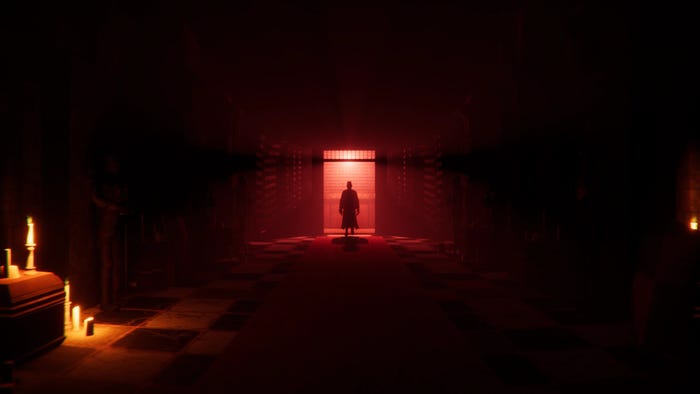In this analysis, Emily Short looks at storytelling and narrative in Wadjet Eye's Emerald City Confidential, a PC adventure title which features a film noir-esque detective investigating Oz.

[In this new analysis, Emily Short looks at storytelling and narrative in Wadjet Eye Games' Emerald City Confidential, which features a film noir-esque detective investigating Oz -- and finds that despite being derivative in some gameplay respects, it does some pleasant things with characterization, and is far more than a fannish tribute to the books.] Emerald City Confidential is a graphical adventure by Wadjet Eye Games, under the creative direction of Dave Gilbert. The protagonist, Petra, is a film-noir-esque detective led to explore deeper and deeper into the web of lies at work in the Emerald City of Oz, which is not really at all the way you may remember it from the books; she spends most of her time questioning people and solving some not-too-difficult puzzles. Structurally, ECC is not doing anything especially new. It is a very linear game with carefully directed gameplay. The magic system's Enchanter-esque spells are strangely specific in their effects and conveniently work only when the designer wills that they should. There are many fetch-quests, and the occasional lock-and-key or get-x-use-x puzzle. The game unabashedly repeats character dialogue verbatim if the player needs to hear some hint over again. Moreover, when it wants to represent characters who are "busy", it will sometimes put them into a loop of repeating dialogue while the player solves some puzzle. In other respects, the gameplay is fun but sometimes too directed. The puzzles are fairer than graphical adventure puzzles of the past, but many of them are so blatantly hinted that the player is deprived of the pleasure of really solving them. I suppose that this is partly because a) this is an adventure game marketed to a casual game audience, so difficulty expectations are lower; b) this is an unusually narrative adventure game in which getting stuck for a long time would be a disruption of the intended pacing. So I'm sympathetic to the tuning considerations that may have gone into this. All the same, I felt that the game already had an excellent external hint mechanism -- one can always consult the journal for suggestions -- so it wasn't always necessary for the game itself to make the logical connections for me. Another small disappointment: Emerald City Confidential is a bit buggy here and there. There are several dialogues that can happen in a sequence other than the one the designers intended, with awkward and comical effect; and the enforcement of game logic breaks down even further in the final portion of the game. At one point I got an actual error message on the screen in a final battle and had to restart the sequence; at another I managed to leave a room in which I think I was supposed to be confined, and was unable to pick up the narrative thread until I returned to it. But since I played a first-day release of the game, it's possible that some of these problems will be patched. These were unfortunate blemishes on an otherwise highly polished and entertaining piece of work: the art is vibrant, the voice acting strong. (Particular favorites: I especially enjoyed the vocal performance of the Tin Man, and the visual punchline of walking into the Frogman's office for the first time.) The music worked, too, which is to say that I noticed it several times with enjoyment, and it never annoyed me enough to prompt me to turn it off. This is rare. Still, the real strengths here are strengths of writing and characterization. The Oz setting works out well, and not just because of the initial thrill of subverting childhood icons like Dorothy and the Cowardly Lion. The appeal of the Oz books, at least for me, lay very much in their curious imagery: the sorceress able to swap heads, the Gump, the knowledge pills. The combination of the vivid and the slightly grotesque makes for a memorable adventure game setting. Besides, many of the Oz stories read like adventure game puzzles to start with, full of characters who trick one another, hide things in inventive places, and aren't what they appear to be. It's a natural fit to translate all this into an interactive format and give the player the satisfaction of resolving these problems herself. I especially enjoyed the tribute to the Nome King's ornament collection from the original books, and several of the other puzzles I might also have recognized if I hadn't forgotten so much Oz lore. (I think I was about nine the last time I read one of these.) But it is not necessary to be an Oz fan to appreciate the story. In fact, the game has merits that the original series does not -- not least that it knows what its story is about, and knows also when it is over. Emerald City Confidential digs deep into the Oz material and comes up with some characters not found in any of the major Oz movies -- which is not difficult, considering that most treatments of Oz only cover the first two or three books at most, out of a collection where the canon runs to forty volumes and the apocrypha into the hundreds. From the vast collection of available witches, magicians, mechanical persons, talking animals, and flying furniture, Gilbert uses a selection with the most interesting motives and the most overlapping history. Just occasionally I thought the dialogue could have been more economical -- there are some scenes that take perhaps a third again as long as they need to in order to establish a character note, and some are more on the nose than I would have liked.  Granted, this is especially difficult to avoid when the dialogue also has to convey a constant stream of puzzle hints and be sufficiently robust to be repeated when the player forgets things. All the same, now and then I found myself getting a tiny bit impatient, so that I clicked through rather than listening to the exchanges read aloud. The dialogue-loop gambit also betrayed the story at one particular point. Here I am going to get a bit spoilery, so I suggest skipping the next several paragraphs if you haven't played. (Spoilers ahead.) One late-game scene involves Petra getting angry at Ozma. It was so freighted that having Ozma start to repeat herself when I couldn't solve the puzzle seriously undermined the emotional effect. It didn't help that this scene is one of the least well-clued of the game. Moving forward requires -- uniquely in the whole game -- that the player do something irrational to express Petra's mood, rather than something practical to advance her goals. This is tricky territory even when previous gameplay has laid the groundwork for it. I'm in favor of games that allow the player to act expressively in-character -- it is so satisfying, and it strengthens the feeling of being in tune with the protagonist. It is rather less bonding when "make a dramatic gesture here expressing your anger" becomes a mandatory puzzle goal. First I had to realize that I was supposed to make Petra attack Ozma, and then I had to figure out how. I was further stymied because I'd already tried several other spells and the game hadn't allowed me to cast them, so I assumed all spells were temporarily off-limits; and because I'd cast the relevant attack spell on several people earlier in the game without actually hurting them, I didn't think of it as the kind of spell you'd use when you were violently angry, but as something used defensively to disarm dangerous people (which Ozma clearly was not). In fact, previous evidence made me think that using this spell on a magically powerless person would simply do nothing at all. I would have been more likely to lash out with a spell named, say, Fireball or Freeze Ray or Hammer Of A Thousand Thors. And then, finally, I worked out what Petra was supposed to do, using the book of hints, and I did it, and she thought better of the impulse and took mercy on Ozma instead! This was necessary and in-character, but the emotional force of this whole exchange really, really doesn't work unless the player casts the attacking spell with some fraction of the impulsive instinct that motivates Petra. I can maybe hypothesize what the design challenge was. We want Petra to react to Ozma, so we can't have Ozma just fall silent, because then the player will think that the correct course of action lies elsewhere. But it's probably too bulky and expensive to have a many-minutes-long GlaDOS-style speech here, either, so the game does what it does everywhere else, and loops. Unfortunately, the looping has the opposite effect from the one intended: it reminds the player that the whole sequence is mechanical and makes her less likely to react viscerally. At least, that was what happened in my case. Then again, I may be completely mis-imagining the thinking behind this structure. I wish this scene had worked for me, because it is a key point in the game, and because it is more formally daring than any other sequence. I can see that from the designer's point of view, this was totally Stupid Player of me. (There, the spoilers are over now.) These are relatively minor quibbles about a densely-plotted game, however. The story is the driving force throughout, and the main character has a conflict of motives that becomes more and more clearly delineated. The multi-act design provides structure, but there is enough thematic cohesion to keep the story from feeling episodic. Late game puzzles pick up strands introduced at the very beginning. The player winds up having to seek help from unexpected allies, which I found satisfying both as a puzzle challenge and as an expression of Petra's character development. Best of all, the story took the twist I expected -- but went on to others that I did not see coming at all, ending up finally with a resolution that was not simplistically happy or sad. In fact, it left me faintly uncomfortable, which is a compliment: the main character's choice is probably not the choice I would have made under the same circumstances, but it did seem like the decision Petra would make. Emerald City Confidential turns out to be a story uniquely appropriate to the Oz setting. Oz is most of all a land of grotesque and astounding personal transformations, where a boy named Tip becomes a girl named Ozma, a flesh man is re-embodied in tin, a beautiful woman keeps a wardrobe of alternate heads. Identity is unstable; integrity, mental or physical, is not guaranteed; even the boundary between dumb object and animate creature may be crossed in either direction. Gilbert's story is deeply engaged with this idea of violent transformation -- and that makes it far more than a fannish tribute or mocking subversion of Oz. [Emily Short is an interactive fiction author and part of the team behind Inform 7, a language for IF creation. She also maintains a blog on interactive fiction and related topics. She can be reached at emshort AT mindspring DOT com.]
Granted, this is especially difficult to avoid when the dialogue also has to convey a constant stream of puzzle hints and be sufficiently robust to be repeated when the player forgets things. All the same, now and then I found myself getting a tiny bit impatient, so that I clicked through rather than listening to the exchanges read aloud. The dialogue-loop gambit also betrayed the story at one particular point. Here I am going to get a bit spoilery, so I suggest skipping the next several paragraphs if you haven't played. (Spoilers ahead.) One late-game scene involves Petra getting angry at Ozma. It was so freighted that having Ozma start to repeat herself when I couldn't solve the puzzle seriously undermined the emotional effect. It didn't help that this scene is one of the least well-clued of the game. Moving forward requires -- uniquely in the whole game -- that the player do something irrational to express Petra's mood, rather than something practical to advance her goals. This is tricky territory even when previous gameplay has laid the groundwork for it. I'm in favor of games that allow the player to act expressively in-character -- it is so satisfying, and it strengthens the feeling of being in tune with the protagonist. It is rather less bonding when "make a dramatic gesture here expressing your anger" becomes a mandatory puzzle goal. First I had to realize that I was supposed to make Petra attack Ozma, and then I had to figure out how. I was further stymied because I'd already tried several other spells and the game hadn't allowed me to cast them, so I assumed all spells were temporarily off-limits; and because I'd cast the relevant attack spell on several people earlier in the game without actually hurting them, I didn't think of it as the kind of spell you'd use when you were violently angry, but as something used defensively to disarm dangerous people (which Ozma clearly was not). In fact, previous evidence made me think that using this spell on a magically powerless person would simply do nothing at all. I would have been more likely to lash out with a spell named, say, Fireball or Freeze Ray or Hammer Of A Thousand Thors. And then, finally, I worked out what Petra was supposed to do, using the book of hints, and I did it, and she thought better of the impulse and took mercy on Ozma instead! This was necessary and in-character, but the emotional force of this whole exchange really, really doesn't work unless the player casts the attacking spell with some fraction of the impulsive instinct that motivates Petra. I can maybe hypothesize what the design challenge was. We want Petra to react to Ozma, so we can't have Ozma just fall silent, because then the player will think that the correct course of action lies elsewhere. But it's probably too bulky and expensive to have a many-minutes-long GlaDOS-style speech here, either, so the game does what it does everywhere else, and loops. Unfortunately, the looping has the opposite effect from the one intended: it reminds the player that the whole sequence is mechanical and makes her less likely to react viscerally. At least, that was what happened in my case. Then again, I may be completely mis-imagining the thinking behind this structure. I wish this scene had worked for me, because it is a key point in the game, and because it is more formally daring than any other sequence. I can see that from the designer's point of view, this was totally Stupid Player of me. (There, the spoilers are over now.) These are relatively minor quibbles about a densely-plotted game, however. The story is the driving force throughout, and the main character has a conflict of motives that becomes more and more clearly delineated. The multi-act design provides structure, but there is enough thematic cohesion to keep the story from feeling episodic. Late game puzzles pick up strands introduced at the very beginning. The player winds up having to seek help from unexpected allies, which I found satisfying both as a puzzle challenge and as an expression of Petra's character development. Best of all, the story took the twist I expected -- but went on to others that I did not see coming at all, ending up finally with a resolution that was not simplistically happy or sad. In fact, it left me faintly uncomfortable, which is a compliment: the main character's choice is probably not the choice I would have made under the same circumstances, but it did seem like the decision Petra would make. Emerald City Confidential turns out to be a story uniquely appropriate to the Oz setting. Oz is most of all a land of grotesque and astounding personal transformations, where a boy named Tip becomes a girl named Ozma, a flesh man is re-embodied in tin, a beautiful woman keeps a wardrobe of alternate heads. Identity is unstable; integrity, mental or physical, is not guaranteed; even the boundary between dumb object and animate creature may be crossed in either direction. Gilbert's story is deeply engaged with this idea of violent transformation -- and that makes it far more than a fannish tribute or mocking subversion of Oz. [Emily Short is an interactive fiction author and part of the team behind Inform 7, a language for IF creation. She also maintains a blog on interactive fiction and related topics. She can be reached at emshort AT mindspring DOT com.]
About the Author(s)
You May Also Like









